
Wine Culture and Information since 2002 - Volume 22
 Wine Culture and Information since 2002 - Volume 22 |
|
Issue 223, December 2022 |
Contents |
|
|
Territories and Wines in Search of Identity |
|
From an enological and viticultural point of view, Italy holds a record impossible to achieve for any other country in the world. Italy, in fact, counts the largest number of native varieties of wine grapes, a record that has no equal elsewhere and with a consistent gap even on the country that occupies second place. According to the National Register of Wine Grape Varieties of Italy, there are 610 different registered grapes, both native and international. A considerable number, which – to be precise – could increase considerably in case the various existing clones of many varieties would be counted as well. An important heritage that undeniably places Italy at the top for diversity and ampelographic richness, testifying the long and consolidated winemaking history of this country. In the vineyards of every Italian region can be found, without any difficulty, several native grape vines, often attributable to small territories, such as municipalities. Moreover, in many cases, these varieties have such an “identity” that they are not present anywhere else, not only in the region, but throughout the whole country. An impressive heritage of viticultural biodiversity which, at least in theory, should guarantee an enormous advantage in enological terms. For the majority of the indigenous varieties, that's exactly the case. For others, however, this does not correspond to a clear advantage, at least in terms of the market and commercial competition. The fact of having a magnificent and rich heritage of autochthonous varieties, in fact, does not mean that all of them are impeccably extraordinary in enological or viticultural terms. On closer inspection, in fact, wines produced with some autochthonous varieties do not exactly correspond to important enological criteria, at least if we evaluate them with the modern market and consumers' expectations. In this regard, dozens of examples could be given, a very long list of cases, territories and wines which – evidently – do not achieve the desired success despite the commitment and tenacity of the producers in trying to keep a native grape alive as well as the related wine. Very often it is about operations having the purpose of resuscitating varieties sunk into oblivion for decades, rediscovered more or less by chance, and then brought back to life by extolling the extraordinary identity value of a territory. In these cases, which actually occur more and more often, I always wonder why a certain autochthonous variety has been forgotten for so long, despite its rediscovery always and inevitably promises the highest peaks of the enological Olympus. There must certainly be a reason and it cannot be only because of simple distraction or ominous and wretched fate. After all, if certain varieties have been neglected for decades, there have certainly been valid reasons which have pushed the winemakers of the past towards other varieties. The answer, in this case, is all too simple: the abandonment of a variety – and this does not apply to viticulture only – is justified both by the scarce productive results and by the difficulty of cultivation in relation to what is obtained. To be honest, it should be noted that many of the autochthonous Italian varieties have been sacrificed in the past decades in favor of the so-called “international” varieties which promised great wines and extremely profitable productions. They were even called ameliorative grapes because they were recognized as having an enological superiority. Many of the autochthonous varieties have been therefore uprooted from the vineyards of Italy – thereby consigning them to oblivion – to make room for those varieties which promised to replicate the enological glory of other countries, in particular France. For this reason, the vineyards of Italy have been cheerfully invaded by Merlot, Cabernet Sauvignon and Chardonnay, just to mention the most famous examples. In other cases, and I am talking about an even more distant time, it was phylloxera that caused certain autochthonous varieties to disappear from the vineyards of Italy, certainly the most nefarious event that marked viticulture and winemaking in the 1900s. Also in that case, the vineyards decimated by the dreaded aphid, were repopulated with varieties, transformed in the meantime “resistant” and mainly of French origin. The rediscovery, or better to say, the re-evaluation of certain autochthonous varieties forgotten for decades, it is promptly turned into an event of affirmation of the identity and value of a territory, always supported by an alleged concept of high quality since it is a historical and traditional value of those lands. No offense to anyone, in my opinion “native” does not imply “excellent”. However, the message that they try to support – for evident and legitimate economic and market interests – is that autochthonous, better if forgotten for decades, always corresponds to the marvel of excellent wines, viticultural and enological miracles, magnificent traditions which, as such, are of the highest quality regardless. With a movement of fierce parochialism, because of the rediscovered identity and history of a territory, the usual and inevitable sequence of events punctually begin, claiming, often demanding, the immediate legal recognition of this rediscovered and essential enological quality. It usually begins a war to claim recognition as a Denominazione d'Origine Controllata (Denomination of Controlled Origin, DOC), sometimes also reaching the highest peak of the Italian system represented by the Denominazione d'Origine Controllata e Garantita (Denomination of Controlled and Guaranteed Origin, DOCG). I am not criticizing the rediscovery and re-evaluation of autochthonous varieties and territories: as I have already said, the ampelographic heritage of Italy is absolutely unique in the world and represents an unrepeatable wealth elsewhere. However, it is almost impossible for me not to think, except in cases of ominous disasters that decreed its oblivion, that abandoning one variety in favor of others was undeniably a very precise choice made by the vintners of the past. A choice which, evidently, was not determined by the fact they were “not so intelligent” or superficial in choosing the varieties they decided to cultivate in their vineyards. More simply, a trivial choice of convenience that ensured the best result with the least effort, both economic and agricultural. Varieties – and not only grapes – were abandoned simply because it was no longer convenient to cultivate them, probably not even from a qualitative and enological point of view. This is something that has always happened in agriculture and continues to happen: it is enough to simply consider, for example, the massive conversion of agricultural surfaces in favor of more profitable and favorable crops. Vine and grapes are no exception, of course. From a purely enological and sensorial point of view, these rediscoveries of proud identity do not always correspond to sensational and memorable results. Modern wine making techniques often help, and not a little, to contribute to the production of better wines, often with evident forcing, even at the cost of “creating” characters which in reality do not belong to those grapes. In other cases, however, modern enology succeeds to enhance some varieties, finally capable of expressing their identity, impossible to enhance with the techniques of the past. Of course, quality modern viticultural and agronomic practices also contribute to this and, without which, no grape and no wine would be able to achieve a significant result, despite the enological magic which can be performed in the winery. Sometimes – and I admit this may be because of my limits – I find in the glass wines of rediscovered and re-evaluated native varieties which, frankly, say nothing and with non-existent personalities. Wines which would go unnoticed in comparison with any other wine, overwhelmed by enological practices decidedly much bigger and more powerful than them, or insufficient and inadequate, if not wrong. It is, very likely, my fault, as if a wine is produced with a native variety, rediscovered and re-evaluated with great pomp, it must necessarily be sublime and of impeccable absolute quality. Without exception, of course. Antonello Biancalana
|
||||
Contrasts of Valle d'Aosta Blanc de Morgex et de La Salle and Ischia BiancolellaThe vineyards of the sea meet those of the mountains, in a sensorial and enological comparison which is different in every regard and with the only common element represented by the fact of belonging to the white style. |
|
The sea meets the mountain, better to say, the island meets the highest vineyards in Europe. This month's tasting by contrast will compare the white wines of two unique and rare territories, last but not least, which are characterized by a viticulture which is not always easy and simple. We will in fact pour in our glasses the wines from very different territories, not only for the geographical and enological rarity, but also for the fact of being produced with grapes having very different organoleptic profiles. Rare varieties, which diffusion is rather limited in their respective territories of origin, two autochthonous grapes among the many present in Italy. The first wine we are going to examine is Valle d'Aosta Blanc de Morgex et de La Salle, which vineyards can reach even 1200 meters above sea level, among the highest vineyards in Europe. The second wine, Ischia Biancolella, is produced in the homonymous and suggestive island of Campania, in the Gulf of Naples. These are two special and particular territories which, due to their respective morphological and geographical characteristics, make viticulture a not exactly simple activity, often resorting to cultivation techniques without which the very existence of vineyards would be practically impossible. If it is true the territories where these wines come from are special and unique, these qualities are undeniably true also for the grapes used for their production. Valle d'Aosta Blanc de Morgex et de La Salle is in fact produced with Prié Blanc, an autochthonous variety of this region which is not present in other territories. Biancolella, the variety used for the production of the other wine of our tasting by contrast, is a grape of Greek origins and introduced to the island of Ischia from Corsica, represents the main variety of the island, and it is also cultivated in other areas of Campania. Two very different wines which give the senses distant sensorial qualities, therefore extremely suitable for the purposes of our tasting.
|
|
In the evocative area close to the Alps, near Mont Blanc, there is Morgex and, not far away, La Salle, the two villages giving their name to this wine denomination of Valle d'Aosta. We are in the north-western part of the region, not far from the border with France, in places of fascinating landscape beauty, where it is not difficult to see vineyards. In these lands the cultivation of vines is made difficult both by the temperatures and by the altitude, practically at the limit of the adaptation of the vine. Morgex is, in fact, at an altitude of 920 meters above sea level and La Salle at about 1000, while the vineyards of this fascinating appellation are even cultivated up to over 1200 metres. This is the realm of Prié Blanc, the grape with which Valle d'Aosta Blanc de Morgex et de La Salle is produced, considered as the highest white grape variety in Europe as the vineyards of this territory can be located – in accordance with the production disciplinary – even at 1300 meters above sea level. This interesting white berried variety also has another characteristic making it even more unique in the worldwide wine scene. Thanks to the high altitude, in fact, Prié Blanc is among the very few varieties of the world to be cultivated on its original root. The climatic conditions found at these altitudes, especially the low temperature, are such as to prevent the life and presence of the dreaded phylloxera, therefore Prié Blanc cuttings are not grafted onto roots resistant to this nefarious aphid. The wines produced with this variety – and therefore also the Valle d'Aosta Blanc de Morgex et de La Salle – are characterized by organoleptic finesse, both in the sense of smell and in the taste, with moderate structure and marked crispness. The versatility of Prié Blanc, moreover, allows the production of other styles of wines, in particular sparkling and sweet wines from dried grapes. The vinification is in almost all cases carried out in inert containers, precisely with the aim of preserving and enhancing the refined organoleptic qualities.
|
||||
|
Ischia, the famous island in the Gulf of Naples and belonging to the archipelago of the Phlegrean islands, can be considered a pearl of Italian viticulture and enology. On this beautiful island, in fact, viticulture has a very long history of over a thousand years. There is evidence of the cultivation of vines and the production of wine already at the time of colonization by the ancient Greeks from Evia, who introduced viticulture to the island in the eighth century BC. Near Lacco Ameno, in the northwestern part of the island, a cup was found, dating back to the times of colonization, in which can be read a phrase celebrating the quality of the island's wine, also testifying to Ischia's long winemaking history. For centuries, viticulture has represented one of the economic resources of the island, so much so that it has substantially and significantly influenced both the life and the traditions of its inhabitants. The cultivation of the vine on the island of Ischia can be considered “heroic”, as the particular morphology of the soil and the small surface that can be used for this purpose, impose the adaptation and modification of the territory in order to make it suitable for viticulture. The island's vineyards extend over the steep slopes towards the sea, requiring the necessary construction of terraces supported by tuff dry stone walls. Among the enological glories of the island of Ischia, there is the white berried variety Biancolella, the most common and important grape of the island and which here is capable of producing wines of character and personality. It is believed the origin of this variety is Greece, introduced to the island by the Euboeans, who had previously brought it to Corsica, where it is still present today and known by the name of Petite Blanche. From the island of Ischia, Biancolella has spread to the nearby Procida island and therefore arriving in the hinterland of Campania.
|
The two wines we will examine in this month's tasting by contrast – as already said – are produced in pretty small territories, therefore available in decidedly limited quantities. This premise is necessary because we are aware that the availability of Valle d'Aosta Blanc de Morgex et de La Salle and Ischia Biancolella is not exactly simple. In accordance with the production disciplinary, Valle d'Aosta Blanc de Morgex et de La Salle is produced with 100% Prié Blanc, therefore in choosing this wine we will not have to pay particular attention as we will have the certainty of its composition. As for Ischia Biancolella, in accordance with its production regulations – exactly as happens for the majority of Italian appellation wines – the minimum percentage of the grape declared on the label must be at least 85%. We will therefore pay attention to make sure the wine is produced with 100% Biancolella. In both cases, we will choose wines produced with the use of inert containers, a wine making factor which however is typical for the production of these wines. The two bottles belong to the latest harvest and are served in tasting glasses at a temperature of 10 °C (50 °F). We can now start our tasting by contrast and proceed with the evaluation of the appearance of the two wines. The first wine we examine is Valle d'Aosta Blanc de Morgex et de La Salle, therefore let's tilt its glass over a white surface, for example a sheet of paper. Let's observe the base of the glass, where the thickness of the wine is greater: the white from Valle d'Aosta shows a brilliant and intense greenish yellow color, very high transparency. Let's now evaluate the nuance of Valle d'Aosta Blanc de Morgex et de La Salle, observing the wine towards the opening of the glass, where the thickness is thinner, in which the greenish yellow is confirmed. Let's now pass to the evaluation of the appearance of Ischia Biancolella and, like for the previous wine, tilt its glass over the white surface. The color of the wine from Campania is decidedly darker than the wine of Valle d'Aosta: here the color is decidedly intense and brilliant straw yellow, with very high transparency. Let's now evaluate the nuance of the second wine, towards the opening of the glass, in which the straw yellow base color is confirmed. The olfactory profiles of Valle d'Aosta Blanc de Morgex et de La Salle and Ischia Biancolella are characterized by very different qualities, in which both the specific personality of the grapes used for their production and the characteristics of the respective territories influence their aromas. Valle d'Aosta Blanc de Morgex et de La Salle, produced with 100% Prié Blanc grape, is characterized by an olfactory profile of great elegance and finesse, in which can be often perceived herbaceous aromas. The primary character of this wine is expressed by fruits and flowers, very often by sensations recalling citrus fruits – in particular, grapefruit – as well as pear, green apple, peach and tropical fruits, such as pineapple, finally almond. The world of flowers is well represented by hawthorn, often accompanied by acacia and broom. Valle d'Aosta Blanc de Morgex et de La Salle is also characterized by its herbaceous profile, in which hay can often be recognized, as well as aromatic herbs, such as thyme and sage. The olfactory profile of Ischia Biancolella is quite different, mainly characterized by fruits, in particular, apple, pear, plum, peach, citrus fruits and almond. The world of flowers of Biancolella is mainly expressed by broom and hawthorn. Finally, there are sensations recalling exotic fruit, in particular pineapple, and – sometimes – a pleasing hint of honey. Let's continue this month's tasting by contrast and proceed with the evaluation of the olfactory profiles of Valle d'Aosta Blanc de Morgex et de La Salle and Ischia Biancolella. As for the previous phase, the first wine we will examine is Valle d'Aosta Blanc de Morgex et de La Salle. Let's hold the glass in vertical position and, without swirling, do the first smell in order to evaluate its opening. From the glass we perceive – clear and clean – the aromas of pear, green apple, peach and hawthorn, as well as a pleasing sensation of citrus fruits in which grapefruit can be recognized. After having swirled the glass and carried out the second smell, to the nose we perceive the herbaceous character of this wine, in particular the sensations reminiscent of hay, thyme and sage, as well as broom and acacia. Finally, the olfactory profile of Valle d'Aosta Blanc de Morgex et de La Salle is completed with pineapple and almond. Let's now pass to the evaluation of the opening of Ischia Biancolella, therefore proceeding with the first smell. From the glass emerge intense aromas of apple, citrus fruits, plum and hawthorn, as well as pear and broom. Let's now swirl the glass – in order to favor the development of the other aromas – and proceed with the second smell. The olfactory profile of Ischia Biancolella is completed with peach, pineapple, anise, almond and a pleasing touch of honey. Let's now pass to the evaluation of the gustatory profiles of the two wines of our tasting by contrast, starting – as in the previous phases – from the Valle d'Aosta Blanc de Morgex et de La Salle. The first quality we will examine is the attack, that is the gustatory sensations perceived in the mouth at the first sip. Valle d'Aosta Blanc de Morgex et de La Salle is immediately recognized for its marked crispness and a pleasing mineral sensation, reaching balance thanks to the effect of alcohol, not excessively intense but certainly suitable for this type of wine. In the mouth we perceive flavors of green apple, pear, peach and grapefruit, good correspondence to the nose. Let's now pass to the evaluation of the attack of Ischia Biancolella, then let's take a sip of the wine from Campania. In the mouth we perceive, also in this case, a clear sensation of crispness and minerality, as well as a decidedly more robust structure than the previous wine. The balance of the wine is obtained, also in this case, thanks to the effect of alcohol. In the mouth, moreover, we perceive the flavors of apple, pear, plum and peach. Let's end this month's tasting by contrast with the evaluation of the final sensations the two wines leave in the mouth after swallowing, in particular the taste-olfactory persistence. The finish of Valle d'Aosta Blanc de Morgex et de La Salle is intense and clean, in the mouth we continue to perceive the pleasing sensation of crispness given by acidity, as well as flavors of green apple, grapefruit, pear, pineapple and hints reminiscent of almond. In the mouth is also perceived a sensation of finesse and elegance, with a very good persistence. The finish of Ischia Biancolella is also persistent, leaving in the mouth a sensation of cleanliness and pleasantness, in which we continue to perceive the good crispness and minerality, with flavors of apple, pear, plum and peach, often followed by the pleasing touch of almond. Let's now place the glasses side by side and do the last smell, first the Valle d'Aosta Blanc de Morgex et de La Salle and then the Ischia Biancolella: the olfactory differences of the two wines are decidedly distant.
|
||||||||
Wines of the Month |
|
|
|
Score legend Prices are to be considered as indicative. Prices may vary according to the country or the shop where wines are bought |

|
|
San Piero 2014 |
|
| Montecalvi (Tuscany, Italy) | |
 Cabernet Sauvignon (95%), Merlot (5%) Cabernet Sauvignon (95%), Merlot (5%) | |
| Price: € 35.00 | Score: |
 Deep ruby red and nuances of garnet red, little transparency. Deep ruby red and nuances of garnet red, little transparency. Intense, clean, pleasing, refined and elegant, starts with hints of
black currant, plum and black cherry followed by aromas of dried violet,
iris, blueberry, cocoa, tobacco, face powder, leather, cigar box, mace,
vanilla and eucalyptus. Intense, clean, pleasing, refined and elegant, starts with hints of
black currant, plum and black cherry followed by aromas of dried violet,
iris, blueberry, cocoa, tobacco, face powder, leather, cigar box, mace,
vanilla and eucalyptus.
 Properly tannic attack and however balanced by alcohol, full body,
intense flavors, pleasing roundness. Properly tannic attack and however balanced by alcohol, full body,
intense flavors, pleasing roundness.
 Persistent finish with flavors of black currant, plum and black cherry. Persistent finish with flavors of black currant, plum and black cherry. 24 months in cask, at least 12 months in bottle. 24 months in cask, at least 12 months in bottle. |
|
 Game, Roasted meat, Stewed and braised meat, Hard cheese Game, Roasted meat, Stewed and braised meat, Hard cheese |
|

|
|
Vigna Vecchia 2016 |
|
| Montecalvi (Tuscany, Italy) | |
 Sangiovese (90%), Canaiolo, Ciliegiolo (10%) Sangiovese (90%), Canaiolo, Ciliegiolo (10%) | |
| Price: € 55.00 | Score: |
 Brilliant ruby red and nuances of garnet red, little transparency. Brilliant ruby red and nuances of garnet red, little transparency. Intense, clean, pleasing, refined and elegant, starts with hints of
black cherry, plum and dried violet followed by aromas of raspberry,
blueberry, blackberry, cocoa, tobacco, cinnamon, leather, licorice, mace,
vanilla and menthol. Intense, clean, pleasing, refined and elegant, starts with hints of
black cherry, plum and dried violet followed by aromas of raspberry,
blueberry, blackberry, cocoa, tobacco, cinnamon, leather, licorice, mace,
vanilla and menthol.
 Properly tannic attack and however balanced by alcohol, good body,
intense flavors, agreeable. Properly tannic attack and however balanced by alcohol, good body,
intense flavors, agreeable.
 Persistent finish with flavors of black cherry, plum and raspberry. Persistent finish with flavors of black cherry, plum and raspberry. 24 months in cask, 12 months in bottle. 24 months in cask, 12 months in bottle. |
|
 Roasted meat, Stewed and braised meat with mushrooms, Broiled meat and barbecue, Cheese Roasted meat, Stewed and braised meat with mushrooms, Broiled meat and barbecue, Cheese |
|
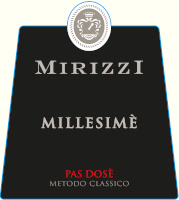
|
|
Verdicchio dei Castelli di Jesi Spumante Metodo Classico Pas Dosé Mirizzi 2015 |
|
| Montecappone (Marches, Italy) | |
 Verdicchio Verdicchio | |
| Price: € 44.50 | Score: |
 Intense straw yellow and nuances of golden yellow, very transparent,
fine and persistent perlage. Intense straw yellow and nuances of golden yellow, very transparent,
fine and persistent perlage.
 Intense, clean, pleasing, refined and elegant, starts with hints of
plum, apple and bread crust followed by aromas of broom, hawthorn, citron,
pear, mango, grapefruit, pineapple, praline, honey, almond and flint. Intense, clean, pleasing, refined and elegant, starts with hints of
plum, apple and bread crust followed by aromas of broom, hawthorn, citron,
pear, mango, grapefruit, pineapple, praline, honey, almond and flint.
 Effervescent and crisp attack, however balanced by alcohol, good body,
intense flavors, agreeable. Effervescent and crisp attack, however balanced by alcohol, good body,
intense flavors, agreeable.
 Persistent finish with flavors of plum, apple and citron. Persistent finish with flavors of plum, apple and citron. The base wine ages for 10 months on its lees. Refermented in bottle and
aged on its lees for 60 months. The base wine ages for 10 months on its lees. Refermented in bottle and
aged on its lees for 60 months.
|
|
 Pasta and risotto with crustaceans and fish, Roasted white meat, Roasted fish, Mushroom soups Pasta and risotto with crustaceans and fish, Roasted white meat, Roasted fish, Mushroom soups |
|
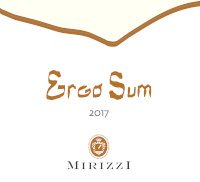
|
|
Castelli di Jesi Verdicchio Riserva Classico Ergo Sum Mirizzi 2017 |
|
| Montecappone (Marches, Italy) | |
 Verdicchio Verdicchio | |
| Price: € 80.00 | Score: |
 Brilliant golden yellow and nuances of golden yellow, very transparent. Brilliant golden yellow and nuances of golden yellow, very transparent. Intense, clean, pleasing, refined and elegant, starts with hints of
apple, plum and almond followed by aromas of hawthorn, broom, pear, medlar,
citron, peach, bergamot, anise, rosemary, saffron, honey, linden and flint. Intense, clean, pleasing, refined and elegant, starts with hints of
apple, plum and almond followed by aromas of hawthorn, broom, pear, medlar,
citron, peach, bergamot, anise, rosemary, saffron, honey, linden and flint.
 Crisp attack and however balanced by alcohol, full body, intense
flavors, pleasing roundness. Crisp attack and however balanced by alcohol, full body, intense
flavors, pleasing roundness.
 Very persistent finish with long flavors of apple, plum and almond. Very persistent finish with long flavors of apple, plum and almond. 12 months in cement tanks, 48 months in bottle. 12 months in cement tanks, 48 months in bottle. |
|
 Stuffed pasta with mushrooms, Roasted fish, Roasted white meat, Cheese Stuffed pasta with mushrooms, Roasted fish, Roasted white meat, Cheese |
|

|
|
Pecorino Supergiulia 2019 |
|
| Cataldi Madonna (Abruzzo, Italy) | |
 Pecorino Pecorino | |
| Price: € 30.70 | Score: |
 Brilliant straw yellow and nuances of straw yellow, very transparent. Brilliant straw yellow and nuances of straw yellow, very transparent. Intense, clean, pleasing, refined and elegant, starts with hints of
apple, plum and citrus fruits followed by aromas of hawthorn, broom, pear,
peach, pineapple, honey, anise, hazelnut and mineral. Intense, clean, pleasing, refined and elegant, starts with hints of
apple, plum and citrus fruits followed by aromas of hawthorn, broom, pear,
peach, pineapple, honey, anise, hazelnut and mineral.
 Crisp attack and however balanced by alcohol, good body, intense
flavors, agreeable. Crisp attack and however balanced by alcohol, good body, intense
flavors, agreeable.
 Persistent finish with flavors of apple, plum and pear. Persistent finish with flavors of apple, plum and pear. 8 months in steel tanks, 10 months in bottle. 8 months in steel tanks, 10 months in bottle. |
|
 Stuffed pasta with fish, Stewed fish with mushrooms, Roasted white meat, Mushroom soups Stuffed pasta with fish, Stewed fish with mushrooms, Roasted white meat, Mushroom soups |
|
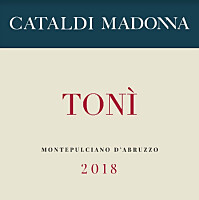
|
|
Montepulciano d'Abruzzo Tonì 2018 |
|
| Cataldi Madonna (Abruzzo, Italy) | |
 Montepulciano Montepulciano | |
| Price: € 42.70 | Score: |
 Intense ruby red and nuances of ruby red, little transparency. Intense ruby red and nuances of ruby red, little transparency. Intense, clean, pleasing, refined and elegant, starts with hints of
plum, black cherry and blueberry followed by aromas of violet, blackberry,
raspberry, cinnamon, carob, tobacco, cocoa, mace, leather, vanilla and
menthol. Intense, clean, pleasing, refined and elegant, starts with hints of
plum, black cherry and blueberry followed by aromas of violet, blackberry,
raspberry, cinnamon, carob, tobacco, cocoa, mace, leather, vanilla and
menthol.
 Properly tannic attack and however balanced by alcohol, good body,
intense flavors, agreeable. Properly tannic attack and however balanced by alcohol, good body,
intense flavors, agreeable.
 Persistent finish with flavors of plum, black cherry and blueberry. Persistent finish with flavors of plum, black cherry and blueberry. 12 months in cask, 12 months in bottle. 12 months in cask, 12 months in bottle. |
|
 Roasted meat, Broiled meat and barbecue, Stewed meat with mushrooms, Cheese Roasted meat, Broiled meat and barbecue, Stewed meat with mushrooms, Cheese |
|
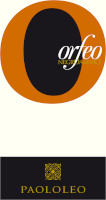
|
|
Orfeo 2020 |
|
| Paolo Leo (Apulia, Italy) | |
 Negroamaro Negroamaro | |
| Price: € 13.50 | Score: |
 Intense ruby red and nuances of ruby red, little transparency. Intense ruby red and nuances of ruby red, little transparency. Intense, clean, pleasing, refined and elegant, starts with hints of
black cherry, blackberry and plum followed by aromas of violet, blueberry,
raspberry, carob, cocoa, tobacco, mace, vanilla and menthol. Intense, clean, pleasing, refined and elegant, starts with hints of
black cherry, blackberry and plum followed by aromas of violet, blueberry,
raspberry, carob, cocoa, tobacco, mace, vanilla and menthol.
 Properly tannic attack and however balanced by alcohol, good body,
intense flavors, pleasing roundness. Properly tannic attack and however balanced by alcohol, good body,
intense flavors, pleasing roundness.
 Persistent finish with flavors of black cherry, blackberry and plum. Persistent finish with flavors of black cherry, blackberry and plum. 3 months in steel tanks, 12 months in barrique. 3 months in steel tanks, 12 months in barrique. |
|
 Stuffed pasta with meat, Roasted meat, Broiled meat and barbecue, Stewed meat with mushrooms, Cheese Stuffed pasta with meat, Roasted meat, Broiled meat and barbecue, Stewed meat with mushrooms, Cheese |
|
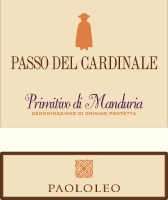
|
|
Primitivo di Manduria Passo del Cardinale 2021 |
|
| Paolo Leo (Apulia, Italy) | |
 Primitivo Primitivo | |
| Price: € 9.90 | Score: |
 Intense ruby red and nuances of ruby red, little transparency. Intense ruby red and nuances of ruby red, little transparency. Intense, clean, pleasing, refined and elegant, starts with hints of
blackberry, black cherry and dried violet followed by aromas of plum,
blueberry, carob, tobacco, tamarind, chocolate, mace, vanilla and menthol. Intense, clean, pleasing, refined and elegant, starts with hints of
blackberry, black cherry and dried violet followed by aromas of plum,
blueberry, carob, tobacco, tamarind, chocolate, mace, vanilla and menthol.
 Properly tannic attack and however balanced by alcohol, good body,
intense flavors, pleasing roundness. Properly tannic attack and however balanced by alcohol, good body,
intense flavors, pleasing roundness.
 Persistent finish with flavors of blackberry, black cherry and plum. Persistent finish with flavors of blackberry, black cherry and plum. 3 months in barrique, 6 months in steel tanks. 3 months in barrique, 6 months in steel tanks. |
|
 Broiled meat and barbecue, Roasted meat, Stewed meat with mushrooms, Cheese Broiled meat and barbecue, Roasted meat, Stewed meat with mushrooms, Cheese |
|
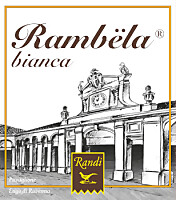
|
|
Rambëla Bianca 2021 |
|
| Randi (Emilia-Romagna, Italy) | |
 Famoso Famoso | |
| Price: € 10.00 | Score: |
 Intense straw yellow and nuances of straw yellow, very transparent. Intense straw yellow and nuances of straw yellow, very transparent. Intense, clean and pleasing, starts with hints of plum, apple and
hawthorn followed by aromas of citrus fruits, pear and medlar. Intense, clean and pleasing, starts with hints of plum, apple and
hawthorn followed by aromas of citrus fruits, pear and medlar.
 Crisp attack and however balanced by alcohol, good body, intense
flavors. Crisp attack and however balanced by alcohol, good body, intense
flavors.
 Persistent finish with flavors of plum, apple and medlar. Persistent finish with flavors of plum, apple and medlar. Aged in steel tanks. Aged in steel tanks. |
|
 Pasta and risotto with fish and crustaceans, Sauteed fish, Vegetable flans, Eggs Pasta and risotto with fish and crustaceans, Sauteed fish, Vegetable flans, Eggs |
|
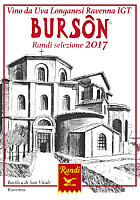
|
|
Burs˘n Selezione 2017 |
|
| Randi (Emilia-Romagna, Italy) | |
 Longanesi Longanesi | |
| Price: € 15.00 | Score: |
 Deep ruby red and nuances of ruby red, little transparency. Deep ruby red and nuances of ruby red, little transparency. Intense, clean, pleasing, refined and elegant, starts with hints of
black cherry, blueberry and plum followed by aromas of violet, black
currant, cinnamon, chocolate, tobacco, tomato leaf, mace, vanilla and
menthol. Intense, clean, pleasing, refined and elegant, starts with hints of
black cherry, blueberry and plum followed by aromas of violet, black
currant, cinnamon, chocolate, tobacco, tomato leaf, mace, vanilla and
menthol.
 Properly tannic attack and however balanced by alcohol, good body,
intense flavors, agreeable. Properly tannic attack and however balanced by alcohol, good body,
intense flavors, agreeable.
 Persistent finish with flavors of black cherry, blueberry and plum. Persistent finish with flavors of black cherry, blueberry and plum. Part of the grapes are dried, 24 months in cask, at least 12 months in
bottle. Part of the grapes are dried, 24 months in cask, at least 12 months in
bottle.
|
|
 Broiled meat and barbecue, Roasted meat, Stewed meat with mushrooms, Cheese Broiled meat and barbecue, Roasted meat, Stewed meat with mushrooms, Cheese |
|
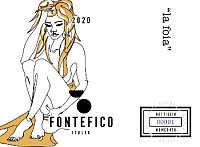
|
|
Abruzzo Pecorino Superiore La Foia 2020 |
|
| Fontefico (Abruzzo, Italy) | |
 Pecorino Pecorino | |
| Price: € 24.00 | Score: |
 Golden yellow color and nuances of golden yellow, very transparent. Golden yellow color and nuances of golden yellow, very transparent. Intense, clean, pleasing and refined, starts with hints of apple, plum
and hazelnut followed by aromas of hawthorn, broom, apricot, citrus fruits,
pear, lemon balm and honey. Intense, clean, pleasing and refined, starts with hints of apple, plum
and hazelnut followed by aromas of hawthorn, broom, apricot, citrus fruits,
pear, lemon balm and honey.
 Crisp attack and however balanced by alcohol, good body, intense
flavors, agreeable. Crisp attack and however balanced by alcohol, good body, intense
flavors, agreeable.
 Persistent finish with flavors of apple, plum and apricot. Persistent finish with flavors of apple, plum and apricot. 11 months in steel tanks, 12 months in cement tanks, 4 months in
bottle. 11 months in steel tanks, 12 months in cement tanks, 4 months in
bottle.
|
|
 Stuffed pasta with fish, Stewed fish with mushrooms, Sauteed white meat, Mushroom soups Stuffed pasta with fish, Stewed fish with mushrooms, Sauteed white meat, Mushroom soups |
|
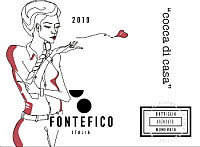
|
|
Montepulciano d'Abruzzo Cocca di Casa 2019 |
|
| Fontefico (Abruzzo, Italy) | |
 Montepulciano Montepulciano | |
| Price: € 15.00 | Score: |
 Deep ruby red and nuances of ruby red, little transparency. Deep ruby red and nuances of ruby red, little transparency. Intense, clean, pleasing, refined and elegant, starts with hints of
plum, blackberry and violet followed by aromas of black cherry, raspberry,
blueberry, carob, chocolate, tobacco, mace, licorice, vanilla and menthol. Intense, clean, pleasing, refined and elegant, starts with hints of
plum, blackberry and violet followed by aromas of black cherry, raspberry,
blueberry, carob, chocolate, tobacco, mace, licorice, vanilla and menthol.
 Properly tannic attack and however balanced by alcohol, good body,
intense flavors, agreeable. Properly tannic attack and however balanced by alcohol, good body,
intense flavors, agreeable.
 Persistent finish with flavors of plum, blackberry and black cherry. Persistent finish with flavors of plum, blackberry and black cherry. 24 months in steel tanks and cask, 6 months in bottle. 24 months in steel tanks and cask, 6 months in bottle. |
|
 Broiled meat and barbecue, Stewed meat with mushrooms, Roasted meat, Cheese Broiled meat and barbecue, Stewed meat with mushrooms, Roasted meat, Cheese |
|
News |
|
In this section are published news and information about events concerning the world of wine and food. Whoever is interested in publishing this kind of information can send us a mail to our address.
|
AquavitaeReview of Grappa, Distillates and Brandy |
|
|
||||||||||||
Wine Guide ParadeSeptember 2022
|
| |||||||
Privacy Policy | |||||||


| Copyright © 2002-2024 Antonello Biancalana, DiWineTaste - All rights reserved |
| All rights reserved under international copyright conventions. No part of this publication and of this WEB site may be
reproduced or utilized in any form or by any means, electronic or mechanical, without permission in writing from DiWineTaste. |